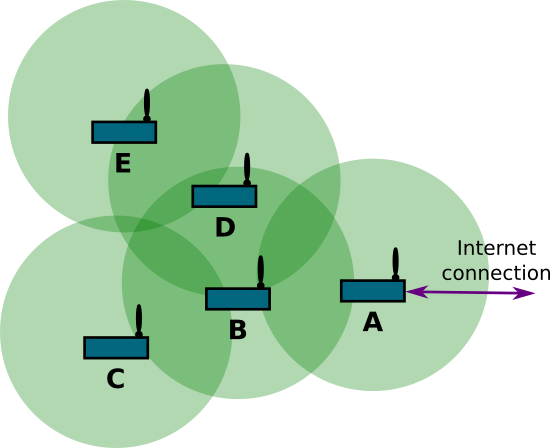Wireless mesh networks
Categories: networks network hardware
A wireless access point has a limited range, and the signal doesn't travel through walls very well. This means that in larger offices, schools, or even houses, a wireless signal might not be available in very part of the building.
One way to extend the range is to have a second node (B), within range of the node (A) that is physically connected to the Internet. This extends the range to other parts of the building. Any computer which is within range of A or B can connect to the Internet.

It is possible to take this idea further, and construct a [[Mesh network topology|mesh network]] with wireless nodes.

Each node in the network is a wireless access point. The nodes communicate with each other via wifi, with one of the nodes connected to the Internet.
This allows the wireless network to extend beyond the range of the original wireless access point. It is a good way to make wireless access available throughout a medium sized office (or a large house). Computers, printers and other devices connect to their nearest wireless node.
Provided each node is within range of a two or more other nodes, the mesh will be fault tolerant - even if a node fails, the entire network will still be accessible by using alternative routes.
Specialised wifi nodes are available that are designed to create mesh networks with minimal configuration, so the network is easy to set up and extend.
The internet of Things
The idea behind the Internet of Things (IoT) is to connect all sorts of devices to the Internet, even those that are not currently considered to be "intelligent" devices. Some examples are:
- Smart homes - central heating that can be turned on remotely before you get home, fridges that can order food when things run out, even simple devices like microwaves or kettles can detect faults and order their own replacements.
- Smart cities - street lights and signs that can be controlled and monitored for faults remotely, intelligent traffic lights to help with congestion, bus stops that display up to date arrival times and many more.
- Agriculture - remote monitoring of temperature, soil moisture and nutrients to help produce more crops with less irrigation and fertilisers
- And many more...
In most cases, IoT nodes have to be small, self-contained, and very cheap. They require an Internet connection, but it doesn't usually need to be a fast connection. A wireless mesh network, where all the devices communicate with each other to send messages can be a good solution.
See also
Sign up to the Creative Coding Newletter
Join my newsletter to receive occasional emails when new content is added, using the form below:
Popular tags
555 timer abstract data type abstraction addition algorithm and gate array ascii ascii85 base32 base64 battery binary binary encoding binary search bit block cipher block padding byte canvas colour coming soon computer music condition cryptographic attacks cryptography decomposition decryption deduplication dictionary attack encryption file server flash memory hard drive hashing hexadecimal hmac html image insertion sort ip address key derivation lamp linear search list mac mac address mesh network message authentication code music nand gate network storage none nor gate not gate op-amp or gate pixel private key python quantisation queue raid ram relational operator resources rgb rom search sort sound synthesis ssd star network supercollider svg switch symmetric encryption truth table turtle graphics yenc